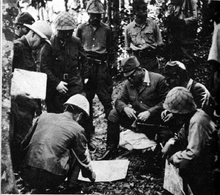Tsukada Rikichi

Tsukada Rikichi ( Japanese 塚 田 理 喜 智 ; * December 15, 1892 , † May 19, 1958 in Sapporo ) was a lieutenant general in the Imperial Japanese Army in World War II .
Life
Tsukada was recorded in December 1916 at the rank of lieutenant in the Imperial Japanese Army and completed in November 1924, the Army Academy from. In December he was transferred to a post in the Army General Staff , where he remained until July 1927. Then he was transferred to the training unit of the Shimoshizu Army Aviation School until March 1930, where he last worked as a teacher for the Army Air Force . Until February 1932 he was employed in various staff positions including the 20th Division and the Kwantung Army , before he was with the 7th Air Regiment until March 1933. This was followed by a post at the headquarters of the China Garrison Army until May 1936 , before he served in the intelligence department of the Northern China Regional Army in Nanjing until 1938 .
After a promotion to Colonel General of the Aviators, Tsukada was used as commander of the 7th Air Regiment from March 1938. From 1939 to February 1942 he was chief of staff of the 1st Air Group, where he was promoted to major general in August 1941 . From February 1942 to February 1944 he was the commanding general of the 3rd Air Brigade, before he served until August 1944 under Kinoshita Satoshi as Chief of Staff of the 3rd Air Army , which was responsible for the area around Singapore and the Malay Peninsula . Until November of the same year he was briefly in command of the training unit for airborne operations before he became the commanding general of the newly formed Dai-1 Teishin Shūdan , the “1. Air Storm Division ”, in the Philippines . Until February 1945 he was subordinate to this major unit of the 4th Air Army before he was subordinated to the 14th Regional Army on Luzon , which was only a formal change, as Tsukada had already been on Luzon before. There he had already received on January 1, 1945, in preparation for the Battle of Luzon , from Commander-in-Chief Yamashita Tomoyuki the supreme command of the Kembu group formed from parts of the 14th Regional Army . This large association, about 30,000 strong, was supposed to defend , among other things, the Clark Field airfield and its surroundings. On January 27, his troops first came into contact with units of the US Army , which were able to conquer Clark Field in fierce fighting until January 31. Under Tsukada's orders, however, around 25,000 soldiers managed to retreat to the mountains west of the airfield and maintain a stable line of defense there until the end of February. During these fighting, however, the connection to the Japanese troops on the island of Corregidor was lost, which had also been under the command of Tsukadas and were now on their own.
For his defensive successes, Tsukada was promoted to lieutenant general in March 1945. By the beginning of April, the orderly defense of the Kembu group finally collapsed, which is why Tsukada ordered his troops on April 6 to disband and wage a guerrilla war against the US Army. On September 2nd he surrendered with a small remainder of his troops and went into captivity, from which he was released in 1946. He died in 1958 in the northern Japanese Sapporo to lung cancer .
Individual evidence
literature
- Richard Fuller: Japanese Generals 1926–1945. 1st edition. Schiffer Publishing Ltd., Atglen, PA 2011, ISBN 978-0-7643-3754-3 .
Web links
- Tsukada Rikichi in the Pacific War Online Encyclopedia. Retrieved November 12, 2011.
| personal data | |
|---|---|
| SURNAME | Tsukada, Rikichi |
| ALTERNATIVE NAMES | 塚 田 理 喜 智 (Japanese) |
| BRIEF DESCRIPTION | Japanese lieutenant general |
| DATE OF BIRTH | December 15, 1892 |
| DATE OF DEATH | May 19, 1958 |
| Place of death | Sapporo |